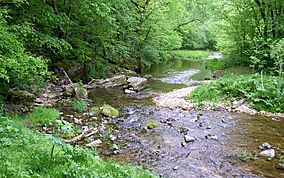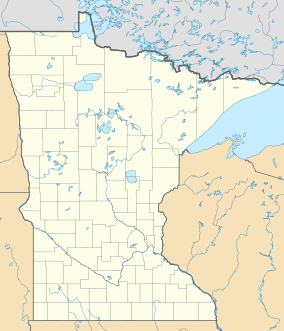Beaver Creek Valley State Park facts for kids
Quick facts for kids Beaver Creek Valley State Park |
|
|---|---|

East Beaver Creek, a spring-fed trout stream, has carved the narrow Beaver Creek Valley.
|
|
| Location | Houston, Minnesota, United States |
| Area | 1,187 acres (4.80 km2) |
| Elevation | 833 ft (254 m) |
| Established | 1937 |
| Governing body | Minnesota Department of Natural Resources |
Beaver Creek Valley State Park is a special place in Minnesota, United States. It has a deep, narrow valley that was carved out by East Beaver Creek. This creek is fed by natural springs and is a popular spot for fishing. You can find native brook trout and brown trout here.
The park is located in a heavily forested valley. In some spots, the valley walls are as tall as 250 feet (76 m)! It sits among the farmlands of southeastern Minnesota, near the town of Caledonia. The park was built in the 1930s by a group called the Works Progress Administration (WPA). This area is known as the Driftless Area, which means it has many deep valleys carved by streams.
Natural History of the Valley
How the Valley Was Formed
Long, long ago, about 500 to 450 million years ago, shallow seas covered this region. Over time, layers of sediment built up. First, a layer of rock called Oneota dolomite formed. Then came a layer of Jordan sandstone, followed by another layer of dolomite.
Today, the Jordan sandstone forms the tall walls of the valley. The top layer of dolomite sits on the ridges above. Both of these rock types let water pass through them. This is why you can find many natural springs in the park!
The Driftless Area Explained
Most of the Midwestern United States was covered by thick ice sheets during past ice ages. These glaciers left behind a lot of rocky material called "till" or "drift." However, the Driftless Area, where Beaver Creek Valley is, was not covered by ice.
Because there were no glaciers, streams and rivers in this area had a much longer time to cut into the ground. This is why you see such deep valleys and high ridges here.
East Beaver Creek
East Beaver Creek flows through the park and joins West Beaver Creek at the northern end. Both creeks are part of the Root River system. After heavy rains, the creek can experience flash floods, so it's important to be aware of weather changes. The creek is home to wild populations of brown trout.
Plants and Animals
Plants of the Park
Inside the valley, you'll find many hardwood trees that like wet soil. These include black ash, willow, box elder, cottonwood, and elm. Higher up on the valley walls and on the flat land above, the forest changes. Here you'll see a mix of maple, walnut, basswood, and oak trees.
Some slopes that face south and west have small patches of prairie plants. These are special because they are remnants of what the land looked like long ago. The park is also home to several rare or endangered plant species.
Animals of the Park
Many different animals live in Beaver Creek Valley State Park. You might spot birds like Acadian flycatchers and Louisiana waterthrushes. These birds are quite rare in Minnesota and choose this park to build their nests.
Mammals that roam here include raccoons, deer, badgers, minks, beavers, gray and red foxes, muskrats, and wild turkeys.
The park also has timber rattlesnakes, but they are rarely seen by visitors. It's always a good idea to stay on marked trails and be aware of your surroundings when hiking in nature.
Park History
Early Human History
Long before European settlers arrived, a Native American village was located in Beaver Creek Valley. This has been discovered through archaeological surveys. Some ancient stone tools have also been found in the area.
European Settlement and Schech's Mill
European settlers began moving to this area in the 1850s. They were drawn by the rich farming soil, the hardwood trees for lumber, and the streams that were perfect for building mills. Much of the land around Beaver Creek Valley was too rugged for farming. So, many parts were used for pasture (where animals graze) or as woodlots (areas for cutting wood).
In 1876, a gristmill was built on Beaver Creek. This mill, now known as the Schech Mill, is very special. It's the last water-powered mill in Minnesota that still uses its original equipment!
Creating the State Park
The idea for Beaver Creek Valley to become a state park came about in the 1930s. The state started buying land for the park in 1936. The Minnesota Legislature officially approved the park the next year, in 1937.
A small crew from the Works Progress Administration (WPA) arrived in 1938. They helped build the park's entrance road, structures to control floods, picnic areas, and hiking trails. The campground was developed a bit later, in the late 1940s.
Park Boundaries and Management
In the late 1960s, there was a plan to make the park bigger. This was because people were worried that landowners on the blufftops might cut down trees, which could cause erosion. However, many owners didn't want to sell their land. It was good farmland and not easy for park visitors to reach from the valley floor.
Because of this, in 1978, the state legislature changed the park's official boundaries. They decided the park would only include land already owned by the state. However, there's still a rule that allows more land to be added if owners are willing to sell. The Minnesota Department of Natural Resources has been interested in adding the Schech Mill to the park. But the family who has owned the mill since 1887 prefers to keep it private and operate it as a tourist attraction.
Balancing Nature and Recreation
In the mid-1990s, the park faced a challenge between different interests: fishing and birdwatching. To help large trout, park staff were placing rocks along the creek banks. This helped prevent erosion and created hiding spots for fish.
However, some birds, like Louisiana waterthrushes and cerulean warblers, build their nests at the base of trees near the creek. Some of these trees were being removed to make space for the rocks. After discussions about how to manage the park's wildlife, a compromise was reached. The upper and lower parts of East Beaver Creek were changed to help the fish, while the middle section was left untouched to protect the birds' nesting areas.
Recreation and Activities
Fishing for brown trout is a very popular activity at Beaver Creek Valley State Park. Some large trout, 16 inches (41 cm) or more, have been caught here!
Because the valley is so narrow, the campground sites are spread out on both sides of the park road.
- There are 42 drive-in campsites, and 16 of these have electrical hookups.
- You can also find 6 walk-in sites.
- There is a camper cabin available.
- At the end of the park road, there are 3 group campsites.
The park also offers 8 miles (13 km) of hiking trails for you to explore the beautiful valley and its surroundings.




